Environment: milieu / climate zone / depth range / distribution range
Écologie
marin bathydémersal; profondeur 100 - 700 m (Ref. 56504). Deep-water; 73°N - 26°N, 30°W - 37°E (Ref. 54564)
Northeast Atlantic: Iceland southward to Cape Bojador (26°N), West Sahara and in the western Mediterranean.
Length at first maturity / Taille / Poids / Âge
Maturity: Lm 25.8 range ? - ? cm
Max length : 60.0 cm TL mâle / non sexé; (Ref. 3397); common length : 25.0 cm TL mâle / non sexé; (Ref. 3397); poids max. publié: 0.00 g; âge max. reporté: 16 années (Ref. 108908)
Épines dorsales (Total): 0; Rayons mous dorsaux (Total): 85-94; Rayons mous anaux: 64 - 74. Dorsal fin origin closer to tip of snout than to anterior edge of eye. Dorsal and anal fins terminate just a little on the blind side of the caudal peduncle. Lateral line forms a distinct curve above the pectoral fin. Dorsal and anal fin with indefinite darker spots posteriorly.
Adults occur on soft bottoms. Depth range from 100-400 m (Ref. 06302) and from 288-700 m in the eastern Ionian Sea (Ref. 56504). Feed on small bottom-living fishes as well as squids and crustaceans (Ref. 4703). Spawning occurs in deep waters off Iceland and west of the British Isles (Ref. 35388).
Nielsen, J.G., 1990. Scophthalmidae. p. 1026. In J.C. Quero, J.C. Hureau, C. Karrer, A. Post and L. Saldanha (eds.) Check-list of the fishes of the eastern tropical Atlantic (CLOFETA). JNICT, Lisbon; SEI, Paris; and UNESCO, Paris. Vol. 2. (Ref. 6501)
Statut dans la liste rouge de l'IUCN (Ref. 130435)
Menace pour l'homme
Harmless
Utilisations par l'homme
Pêcheries: hautement commercial
Plus d'informations
RéférencesAquacultureProfil d'aquacultureSouchesGénétiqueElectrophoresesHéritabilitéPathologiesTraitementNutrientsMass conversion
Outils
Articles particuliers
Télécharger en XML
Sources Internet
Estimates based on models
Preferred temperature (Ref.
123201): 6.3 - 11.4, mean 7.7 °C (based on 165 cells).
Phylogenetic diversity index (Ref.
82804): PD
50 = 0.7520 [Uniqueness, from 0.5 = low to 2.0 = high].
Bayesian length-weight: a=0.00479 (0.00375 - 0.00610), b=3.10 (3.03 - 3.17), in cm total length, based on LWR estimates for this species (Ref.
93245).
Niveau trophique (Ref.
69278): 4.3 ±0.1 se; based on diet studies.
Generation time: 6.5 (5.5 - 9.2) years. Estimated as median ln(3)/K based on 23
growth studies.
Résilience (Ref.
120179): Milieu, temps minimum de doublement de population : 1,4 à 4,4 années (K=0.13; tm=2-4; Fec = 26,522; tmax=16).
Prior r = 0.51, 95% CL = 0.33 - 0.76, Based on 6 stock assessments.
Fishing Vulnerability (Ref.
59153): High vulnerability (60 of 100).
Climate Vulnerability (Ref.
125649): Low vulnerability (25 of 100).
Nutrients (Ref.
124155): Calcium = 21.2 [10.9, 41.1] mg/100g; Iron = 0.309 [0.126, 0.732] mg/100g; Protein = 19.3 [17.5, 20.9] %; Omega3 = 0.35 [0.17, 0.77] g/100g; Selenium = 14.6 [4.4, 46.1] μg/100g; VitaminA = 12.1 [2.5, 55.2] μg/100g; Zinc = 0.285 [0.146, 0.582] mg/100g (wet weight); based on
nutrient studies.
